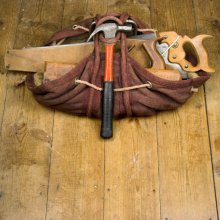The struktör's eight tools
Datum: 2010-03-03 10:27

To be a ”struktör” is very much about visualizing; to clarify what at first sight might be experienced as messy. By structuring and visualizing you make it all apprehensible and tangible. Then it will be easy to see what is big and what is small (it can be problems, opportunities or something else), what’s important and what is not so important, what the next natural step will be et c.
This type of work is a lot easier if you have well adapted tools, tools which you are comfortable with and enjoy working with. The struktör’s eight tools are:
Notepaper for different tastes
I definitely prefer Matton’s yellow AD note pad, which contains unlined, slightly coated (i.e. glossy) sheets of paper. On these papers the pen slides perfectly and if I use markers or felt-tip pens, they don’t bleed through the paper.
A newcomer to the world of note pads are the Whitelines pads, that I really can recommend.
Usually, I use this pad in landscape format, placed on the table, and I let the structure emerge spontaneously onto the paper, guided by whatever comes to mind. I group the notations by topic and preferably link them together with arrows and lines. I write the to-do-tasks which come to mind in the meantime, in brackets. That makes it easy for me to skim through the notes after the meeting and gather the ”to-do tasks “and compile them into my system.
Pens
Most important is a black ball point pen with fine pointed tip, preferably Pilot G‑TEC-C4 which has 0.4 mm thick tip. The black ink contrasts nicely against the bright, white sheet and the script never smears, not on any paper.
Markers
Three markers or felt-tip pens in different colors, to draw timelines, connection lines, boundaries, titles, headlines and symbolic words with. I really like the Japanese Copic Marker pens with two tips, a fine tip at one end and broad tip at the other.
Whiteboard markers
I always carry a set of whiteboard markers in four colors with me. Often, the pens in the conference room where I will work are so dry or worn out that it is difficult to see what is written on the board.
All too many times have the dodgy markers reduced dynamics at a critical stage in a workshop. If I bring my own, I know that they’ll write well.
Mind map tools
With a mind map program on your computer, it is easy to create a structure which can also be dynamic, which means that you can minimize or hide the parts that you do not want to see at the moment.
I can really recommend MindManager from Mindjet, but I know there’s at least a couple of free alternatives that works just fine (e. g. Xmind).
Process Drawing Software
A struktör is often in need of a program to draw clear processes and procedures easily. I use Microsoft Visio for these tasks, which allows me to quickly and easily draw up coherent processes, preferably with pictures and symbols to make them easier to comprehend.
I’m quite unorthodox when it comes to dealing with process maps. The most important thing for me is that they are apprehensible for the receiver, not that they meet the standards.
A conviction that everything can be made easier
The fundamental attitude and belief that everything can be done more easily will get you a long way. Too often I feel that things are made more complicated than what is necessary, often due to that you’re taking too many precautions for all eventualities without really thinking about what actual threats you’re up against. Perhaps there is, somewhere, something that can’t be made easier, but you’ll be right at least 9 out of 10 times, and that’ll be worth it, don’t you think.
A positive, affirmative attitude
With a positive attitude, you’re well equipped to deal with complex, unstructured problems. You’ll occasionally find that you don’t know how to bone out a huge mess, but if you stay convinced and confident that you’re going to find clarity, you’ll also find clarity a lot more times than if you approach problems with a voice that tells you that “this will never work” grinding in the back of your mind.
Then it may turn out that the clarity or insight in the end leads to a different solution than you originally had in mind, and then you’ll really have great use of using your affirmative attitude. We shouldn’t think that we’re in full control of how everything is going to turn out. Often it turns out to be better than what we had in mind in the first place, just a little different.
Those were some tangible and some abstract tools that every struktör needs.
What do you use?
Which are your favorite tools that are essential for you to do your work?
Leave a comment below.




